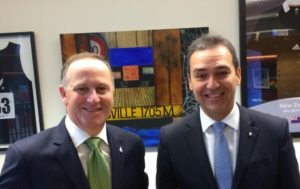Australian state looks to New Zealand for export lessons
An Australian state is looking to follow the blueprint of neighbouring export powerhouse New Zealand in a bid to turn its economy around.
Steven Marshall’s Liberal Government won the March 17 state election, ending 16 years of Labor Party rule in South Australia.
Still in his first 100 days of office, Marshall has vowed to lower taxes, streamline approval processes and grow exports.
Several aspects of his plan seek to follow the success of New Zealand when John Key was Prime Minister from 2008-2016. During this time Key lifted the country out of recession forged strong export ties with China and helped develop several strong export industries.
Led by the dairy industry, six of New Zealand’s top seven export categories are food or drink related and include meat, fruit, seafood and wine. New Zealand’s exports hit a record high of A$50.2 billion (NZ$53.7 billion) in 2017, up 11 per cent on 2016 and beating the previous record of 2014.
Despite having about 7 per cent of Australia’s population, South Australia only accounts for 4 per cent of Australia’s total exports. Marshall said this compared to 7.4 per cent of Australia’s merchandise exports in 2002.
Like New Zealand, South Australia’s major export categories are dominated by primary industries such as wheat, meat and wine.
China is the biggest trading partner of both jurisdictions with Asia accounting for more than half of all exports in both economies. However, Marshall said South Australia’s exports to China had lost ground against other Australian states in recent years.
He said New Zealand’s success was in pinpointing sectors, such as the dairy industry, and aligning them with targeted export markets. He said he had already met with three of South Australia’s largest red meat exporters with a view to increasing their opportunities.
“New Zealand had a strategy of focus from their government – not a scattergun approach,” Marshall said.
“Similarly, here in South Australia there are lots of sectors that we need to be looking at, take for example red meat export, already a very significant sector in South Australia but we think it can do better.
“There are opportunities around premium products, but we also can’t lose sight of the fact that we are providing a commodity to the world, so we need to make sure we can pull cost out of the supply chain.
“The success in New Zealand was really thinking about sectors and markets and getting the right structure and focus around those two ideas.”
Former prime minister of New Zealand John Key with Steven Marshall in 2014.
South Australia exported A$14.9b worth of goods ($11.68b) and services ($3.24b) in 2016/17 led by wine ($1.5b), wheat ($1.25b), meat ($1.2b) and copper ($1.15b). Other notable premium food exports included Vegetables and fruit ($828m) and seafood ($285m). Among its major services earners are international students and tourism.
Like South Australia, New Zealand’s biggest customer is China with Asia accounting for more than half of all exports in both economies.
Marshall plans to re-establish South Australian trade offices in Shanghai, Tokyo, Kuala Lumpur, the Middle East and North America in his government’s first term.
He is also merging several government departments into one outward facing ministry of trade, tourism and investment to be the state’s one-stop shop for the rest of the world, and consolidating all agriculture and regional development into one primary industries department.
“We have had an economy that hasn’t engaged particularly well over the past 16 years and we want to change that from day one,” he said.
“One of our fundamental pillars of economic growth is to sell more goods and services interstate and overseas, attract more outside investment into South Australia and turn the tap off South Australian investors sending their money into other jurisdictions, promote tourism and attract more international students to South Australia.”
South Australia’s small population of 1.7 million, the vast majority of who live in the capital Adelaide, and its almost stagnant population growth have been cited as reasons for years of sluggish economic performance.
The state also had the highest unemployment rate – 6.3 per cent – of any Australian state or territory according to February’s ABS Labour Force Survey.
Marshall said he wanted his government to be an enabler of industry rather than telling it how to conduct business
“We want to go sector by sector and say, ‘what are your aspirations and how can the government either get out of the way or facilitate’ but we shouldn’t be saying ‘this is our ambition, and this is what you should be doing in your sector’,” he said.
“Where is the market failure, where is the role for state government – that is going to be our approach, which really revolves around lowering taxes, deregulating, building productive infrastructure and streamlining approval processes.
“John Key did it very successfully … when he finished up in 2016 the capital was flowing back into New Zealand; the people were flowing back into New Zealand.
“We need to do the same thing and we can achieve the same thing here with a growing population, people investing in their own state, attracting more direct investment into South Australia, growing exports and a state feeling more confident about its future.”



